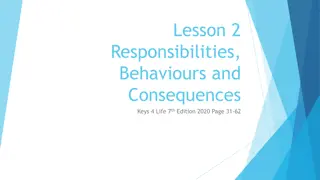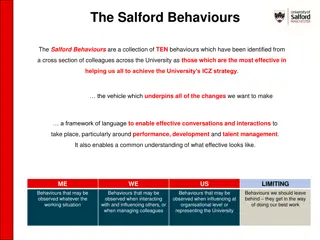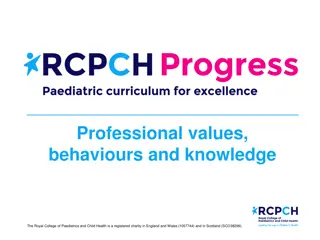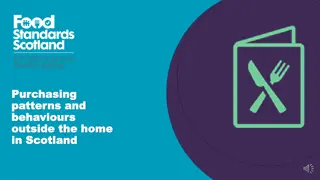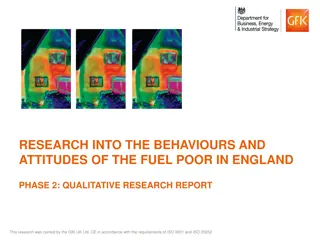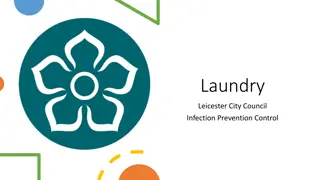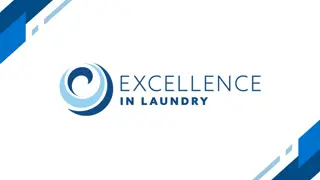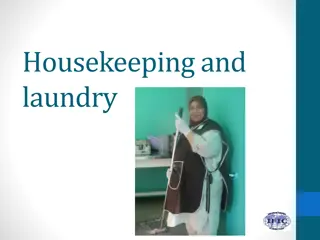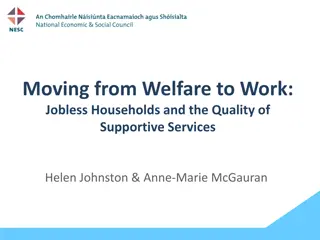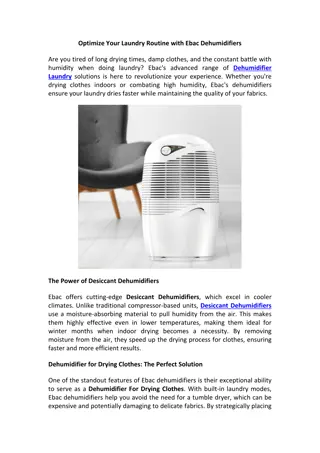Twice as Nice? A Study on Nudges for Household Laundry Behaviours
This longitudinal field study explores the effectiveness of separate versus combined nudges to influence household laundry behaviors. The research, conducted by UBC-DIBS in collaboration with BC Hydro and various partners, aims to understand sustainable behavior change through prosocial and pro-self motivations. The study focuses on the practical impact of laundry habits on energy usage and contributes new insights to the existing literature on nudging strategies. The agenda includes literature review, pilot surveys, main study design, and analysis of results to draw meaningful conclusions.
Download Presentation

Please find below an Image/Link to download the presentation.
The content on the website is provided AS IS for your information and personal use only. It may not be sold, licensed, or shared on other websites without obtaining consent from the author. Download presentation by click this link. If you encounter any issues during the download, it is possible that the publisher has removed the file from their server.
E N D
Presentation Transcript
Twice as nice? A Longitudinal Field Study of Separate vs. Combined Nudges for Household Laundry Behaviours
Todays Research Behavioral Insights research True story of the project We ll do a couple prediction contests be ready! Working paper in progress please interrupt with questions/comments (Lab/b-school style) UBC-DIBS | 3
Co-Authors & Partners BC Hydro Arien Korteland Valerie Rodrigues Netu Sidhu UBC David Hardisty Kirstin Appelt Sid Mookerjee Yanwen Wang Jiaying Zhao UBC-DIBS | 4
Motivation Who s seen An Inconvenient Truth? UBC-DIBS | 5
Key Questions How to nudge sustainable behaviour change? Better to use prosocial motivation, pro-self motivation, or both together? Better to make many questions for behaviour change, or focus on one? UBC-DIBS | 6
Practical Impact Laundry represents about 19% - 28% of home energy use in houses using electric water heating, or 10-12% of household electricity in homes using natural gas water heating (BC Hydro calculations based on data from https://www.energystar.gov/ ) Little research on changing laundry behaviour Identifiable via spikes in metered data (in theory) UBC-DIBS | 7 Image credit: https://en.wikipedia.org/wiki/Clothes_dryer#/media/File:Clothes_Dryer.jpg
Agenda Literature review Pilot surveys (Feb 2021 Apr 2021) Main study design (June 2021 May 2022) Hypotheses Behavioural intention results Self-report results Behaviour logging results Energy meter results Summary & Conclusions UBC-DIBS | 8
Literature Review Short-term vs. long-term effects Most nudging studies only examine a single choice Dynamic energy competitions can be effective long-term (Schultz et al 2007; Wemyss et al., 2019), but only while the feedback is maintained Defaults and auto-escalation are effective long-term (e.g., Benartzi & Thaler 2013) Spillover effects Meta-analysis shows positive spillover effects on intentions, but small negative effects on actual behaviour and policy support (Maki et al., 2019) Single request vs multiple simultaneous requests?? Monetary vs. environmental motivation Financial and environmental framing both improve energy efficient purchases, especially when scaled up (Camilleri & Larrick 2014; Hardisty et al. 2020; Ungemach et al 2018) Financial and environmental messaging both improve energy saving intentions (Steinhorst, Kl ckner, & Matthies, 2015; Steinhorst & Kl ckner, 2018), but not actual behaviour (Steinhorst & Kl ckner, 2018) UBC-DIBS | 10
Literature Review UBC-DIBS | 11 Image credit: https://www.nrcan.gc.ca/energy-efficiency/energuide-canada/energuide-vehicles/21010
Pilot Surveys Perhaps a decal on the laundry machine could provide a lasting nudge? Constant reminder Attractive Low-cost What s the right message? Pilot surveys (Feb 2021 Apr 2021) pre-tested ideas via hypothetical scenarios with online samples from Prolific.co UBC-DIBS | 13
Pilot Survey 2 600 Canadian participants on Prolific assigned to one of 13 conditions Between-participants design: 2 (gain vs. loss framing) x 2 (time horizon: per load vs 10-year) x 3 (motivators: money vs. energy vs. both) + control DVs: Willingness to engage in conservation behaviour (1=Not at all likely, 5=Very likely): - Rewear clothes until dirty - Combine small loads into large loads - Wash laundry in cold water - Hang dry laundry inside or outside UBC-DIBS | 14
Pilot Surveys Survey 2 Money-gain 10-year condition UBC-DIBS | 15
Pilot Surveys Survey 2 Money-loss 10-year condition UBC-DIBS | 16
Pilot Surveys Survey 2 CO2-gain 10-year condition UBC-DIBS | 17
Pilot Surveys Survey 2 CO2-loss 10-year condition UBC-DIBS | 18
Pilot Surveys Survey 2 Combined Money-Gain + CO2-Gain Condition UBC-DIBS | 19
Pilot Surveys Survey 2 Combined Money-Loss + CO2-Loss Condition UBC-DIBS | 20
Pilot Surveys Survey 2 Design Summary Money-gain condition CO2-gain condition Money+ CO2-gain condition CO2-loss condition Money+ CO2-loss condition Money-loss condition Willingness to place decal (1= Definitely not, 5=Definitely yes): Would you be willing to place a removable decal or sticker with this message on your washer or dryer? Willingness to engage in conservation behaviour (1=Not at all likely, 5=Very likely): Rewear clothes until dirty, Combine small loads into large loads, Wash laundry in cold water, Hang dry laundry inside or outside UBC-DIBS | 21
Pilot Survey 2 Which condition do you predict was most effective in Pilot Survey 2? Control Money Gain Money Loss CO2 Gain CO2 Loss Money + CO2 Gain Money + CO2 Loss Null results UBC-DIBS | 22
Pilot Survey 2 None of the interventions were significantly more effective than control Fishing: The combined motivation condition (money + environment incentives) was marginally more effective than money or environment incentive alone in driving cold water washing intentions (p = .067). Takeaway: Providing financial & climate information is not a strong motivator to change laundry behaviours UBC-DIBS | 23
Pilot 4 In qualitative pilot, most people said they care about their clothing, but not microplastics Perhaps a combination of energy, money, and clothing together would be effective? Perhaps a novel motivation (microplastics) would be effective? Vivid imagery might help? 400 Canadian participants on Prolific assigned to one of 8 conditions Between-participants design: 2 (messages: microplastic vs. energy+money+CO2) x 3 (animal: turtle vs. orca vs. polar bear) + microplastics sweater and turtle + control UBC-DIBS | 24
Microplastics sweater and turtle condition Willingness to engage in conservation behaviour (1=Not at all likely, 5=Very likely): Rewear clothes until dirty Combine small loads into large loads Wash laundry in cold water Hang dry laundry inside or outside UBC-DIBS | 25 Image credit: https://www.pngkey.com/maxpic/u2w7w7u2o0q8o0r5/
Pilot Surveys Survey 4 Microplastics turtle condition Willingness to engage in conservation behaviour (1=Not at all likely, 5=Very likely): Rewear clothes until dirty, Combine small loads into large loads, Wash laundry in cold water, Hang dry laundry inside or outside UBC-DIBS | 26
Pilot Surveys Survey 4 Energy turtle condition UBC-DIBS | 27
Pilot Surveys Survey 4 Microplastics bear condition UBC-DIBS | 28
Pilot Surveys Survey 4 Energy bear condition UBC-DIBS | 29
Pilot Surveys Survey 4 Microplastics orcas condition UBC-DIBS | 30
Pilot Surveys Survey 4 Energy orcas condition UBC-DIBS | 31
Pilot Survey 4 Which condition do you predict was most effective in Pilot Survey 4? Control Micro sweater + turtle Micro turtles Energy turtles Micro bears Energy bears Micro orcas Energy orcas Null results UBC-DIBS | 32
Pilot Surveys Survey 4 Place decal Cold Water Label Rewear Combine Load Hang Dry Average Control (n=48) 3.6 3.4 4.2 3.0 3.5 Microplastics Sweater (n=42) 3.5 4.1* 4.0* 4.4 3.2 3.9 Microplastics Turtle (n=48) 3.5 4.2* 3.9* 4.4 3.2 4.0 Microplastics Polar (n=45) 3.6 3.9 3.6 4.3 3.2 3.7 Microplastics Orca (n=45) 3.6 3.9 3.7 4.3 3.2 3.8 Energy turtle (n=40) 3.1 4.1 3.7 4.2 3.1 3.7 Energy Polar (n=45) 3.1 3.8 3.6 4.3 3.1 3.7 Energy orca (n=40) 3.5 3.9 3.6 4.1 3.1 3.7 Note: * = significantly different from control, p < .05 Takeaway: Microplastic messaging with sweater and/or turtle were the most effective UBC-DIBS | 33
Study Design: Participants 1,210 BC Hydro customers recruited from BC Hydro s Team Power Smart program and completed the first survey Follow-up surveys every 3 months, for 1 year total Must have Washing Machine & Clothes Dryer and pay BC Hydro bill 64% women, mean age = 57 UBC-DIBS | 35
Target Laundry Behaviours Re-wear Combine loads Use cold water Hang dry clothes UBC-DIBS | 36
Study Design: Overview Independent Variable: Participants randomly assigned to one of six conditions 1. Control (no decal) 2. Control (QR logging decal) 3. Turtle appeal to change 4 behaviours 4. Fleece appeal to change 4 behaviours 5. Turtle + fleece appeal to change 4 behaviours 6. Turtle + fleece appeal to hang dry Dependent Variables: 1. Laundry behaviour change intentions to re-wear, combine loads, cold water, hang-dry 2. Retrospective self-report of efficiency behaviours, every 3 months for one year 3. Ongoing log of laundry behaviour for one year 4. Energy meter data (hourly level) for one year, including 1-year prior history UBC-DIBS | 37
Control (no decal) UBC-DIBS | 38
Control (logging decal only) As part of your participation in this study, we will mail you a decal to put on your washer or dryer, which will look like the following: UBC-DIBS | 39
Sea Turtle + Bundled When you machine wash and dry your clothes with hot water and hot air, microplastics come out of your clothes. In fact, experts say that between 700,000 and 12 million microfibres can be shed during one single load of laundry. It is estimated that laundry is responsible for 35% of microplastics in our oceans, seriously harming sea turtles and other marine life. You can save our planet by: - Re-wearing clothes more often - Combining loads to run fewer, larger loads of laundry - Washing laundry with cold water, rather than hot water or warm water - Hanging clothes to dry (inside or outside), rather than machine-drying clothes As part of your participation in this study, we will mail you a decal to put on your washer or dryer, which will look like the following: UBC-DIBS | 40
Clothing + Bundled When you machine wash and dry your clothes with hot water and hot air, microplastics come out of your clothes. In fact, experts say that between 700,000 and 12 million microfibres can be shed during one single load of laundry. This breaks down the fabric in your clothes, damaging it and shortening the amount of time you ll be able to enjoy wearing it. You can save your clothes by: - Re-wearing clothes more often - Combining loads to, run fewer, larger loads of laundry - Washing laundry with cold water, rather than hot water or warm water - Hanging clothes to dry (inside or outside), rather than machine-drying clothes As part of your participation in this study, we will mail you a decal to put on your washer or dryer, which will look like the following: UBC-DIBS | 41
Turtle + Clothing + Bundled When you machine wash and dry your clothes with hot water and hot air, microplastics come out of your clothes. In fact, experts say that between 700,000 and 12 million microfibres can be shed during one single load of laundry. This breaks down the fabric in your clothes, damaging it and shortening the amount of time you ll be able to enjoy wearing it. It is also estimated that laundry is responsible for 35% of microplastics in our oceans, seriously harming sea turtles and other marine life. You can save your clothes and save our planet by: - Re-wearing clothes more often - Combining loads to, run fewer, larger loads of laundry - Washing laundry with cold water, rather than hot water or warm water - Hanging clothes to dry (inside or outside), rather than machine-drying clothes As part of your participation in this study, we will mail you a decal to put on your washer or dryer, which will look like the following: UBC-DIBS | 42
Turtle + Clothing + Hang Dry When you machine wash and dry your clothes with hot water and hot air, microplastics come out of your clothes. In fact, experts say that between 700,000 and 12 million microfibres can be shed during one single load of laundry. This breaks down the fabric in your clothes, damaging it and shortening the amount of time you ll be able to enjoy wearing it. It is also estimated that laundry is responsible for 35% of microplastics in our oceans, seriously harming sea turtles and other marine life. You can save your clothes and save our planet by: - Hanging clothes to dry (inside or outside), rather than machine-drying clothes As part of your participation in this study, we will mail you a decal to put on your washer or dryer, which will look like the following: UBC-DIBS | 43
Intentions to engage in efficient laundry behaviours Label Cold Water 3.35 Rewear Combine Load 3.27 Hang Dry 3.53 Average Control (n=217) 3.24 3.34 QR Scan Only Control (n=185) 3.25 3.10 3.19 3.44 3.25 Sea turtle + bundled msg (n=189) 3.61 3.47 3.46 3.60 3.53 Fleece + bundled msg (n=200) 3.58 3.52 3.48 3.61 3.55 Sea turtle + fleece + bundled msg (n=184) Sea turtle + fleece + hang dry msg (n=189) 3.60 3.42 3.40 3.54 3.49 3.56 3.42 3.38 3.77 3.53 Note: Participants answered on a 1-5 scale from 1= much less often to 3= the same to 5= much more often . Subscripts indicate significant difference from control (1) or QR scan only control (2). UBC-DIBS | 45
Intentions to engage in efficient laundry behaviours Summary: All decals increased intentions to improve behaviours Roughly equally effective on intentions UBC-DIBS | 46
Summary: Decal Effectiveness vs Control Intentio ns Self- report Logged Washing Logged Drying Metered Washing Metered Drying Condition Turtle + Bundle Fleece + Bundle Turtle + Fleece + Bundle Turtle + Fleece + Hang Dry UBC-DIBS | 47
Control Self-report Results QR Scan Only Control % Engagement Efficient Behaviours Sea turtle + bundled message Fleece + bundled message 70 Sea turtle+fleece+bundled message Sea turtle+fleece+hang dry message 50 S1 S2 S3 S4 Takeaway: From S1 to S4, participants were marginally less likely to report engaging in laundry efficient behaviours for the control conditions (ps <.1). Sea turtle+fleece+hang dry message and Sea turtle+bundled message were marginally more effective than control conditions at S4 (ps <.1) UBC-DIBS | 49
Self-report Results Control QR Scan Only Control % Engagement Efficient Behaviours Sea turtle + bundled message 70 Sea turtle+fleece+hang dry message 50 S1 S2 S3 S4 Takeaway: From S1 to S4, participants were marginally less likely to report engaging in laundry efficient behaviours for the control conditions (ps <.1). Sea turtle+fleece+hang dry message and Sea turtle+bundled message were marginally more effective than control conditions at S4 (ps <.1) UBC-DIBS | 50
















